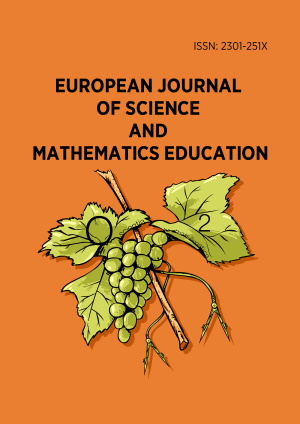Research Article
Greek primary teachers’ views about STEM education
More Detail
1 Department of Primary Education, National and Kapodistrian University of Athens, Athens, GREECE* Corresponding Author
European Journal of Science and Mathematics Education, 13(2), April 2025, 119-136, https://doi.org/10.30935/scimath/16162
Published Online: 12 March 2025, Published: 01 April 2025
OPEN ACCESS 1516 Views 763 Downloads
ABSTRACT
In this paper, primary teachers’ views about STEM education and the conditions of its introduction to primary education are investigated. The results came from 114 questionnaires and 27 structured primary teachers’ interviews. STEM is clearly perceived as an interdisciplinary subject with many advantages, related to the cultivation of students’ scientific thinking and their social skills. Primary teachers support its introduction to primary education, but they believe that it needs better preparation and design. For the successful introduction of the STEM in primary education teachers’ training, the provision of infrastructure and equipment and more time in the timetable is needed. Finally, teachers raise the issue of the need for increased accessibility to STEM education as a means of facing gender, racial and social inequalities. In this line, they demand financial support from the state, to strengthen STEM education in all public schools and not only in well-paid schools.
CITATION (APA)
Mandrikas, A., & Stefanidou, C. (2025). Greek primary teachers’ views about STEM education. European Journal of Science and Mathematics Education, 13(2), 119-136. https://doi.org/10.30935/scimath/16162
REFERENCES
- Amadei, B., & Sandekian, R. (2010). Model of integrating humanitarian development into engineering education. Journal of Professional Issues in Engineering Education and Practice, 136(2), 84–92. https://doi.org/10.1061/(ASCE)EI.1943-5541.0000009
- Anand, N., & Dogan, B. (2021). Impact of informal learning environments on STEM education–Views of elementary students and their parents. School Science and Mathematics, 121(6), 369–377. https://doi.org/10.1111/ssm.12490
- Archer, L., Godec, S., Patel, U., Dawson, E., & Calabrese Barton, A. (2024). “It really has made me think”: Exploring how informal STEM learning practitioners developed critical reflective practice for social justice using the equity compass tool. Pedagogy, Culture & Society, 32(5), 1243–1265. https://doi.org/10.1080/14681366.2022.2159504
- Avery, L. M., & Meyer, D. Z. (2012). Teaching science as science is practiced: Opportunities and limits for enhancing preservice elementary teachers’ self-efficacy for science and science teaching. School Science and Mathematics, 112, 395–409. https://doi.org/10.1111/j.1949-8594.2012.00159.x
- Baillie, C., Pawley, A. L., & Riley, D. (2011). Engineering and social justice in the university and beyond. Purdue University Press. https://doi.org/10.2307/j.ctt6wq5pf
- Bal, A. P., & Bedir, S. G. (2021). Examining teachers’ views on STEM education. European Journal of Education Studies, 8(3), 327–341. https://oapub.org/edu/index.php/ejes/article/view/3650
- Bjerke, A. H., & Solomon, Y. (2019). Developing self-efficacy in teaching mathematics: Pre-service teachers’ perceptions of the role of subject knowledge. Scandinavian Journal of Educational Research, 64(5), 692–705. https://doi.org/10.1080/00313831.2019.1595720
- Bybee, R. W. (2013). The case for STEM education: Challenges and opportunities. National Science Teachers Association Press.
- Calabrese Barton, A., Ermer, J. L., Burkett, T. A., & Osborne, M. D. (2003). Teaching science for social justice. Teachers College Press.
- Campbell, T., & Oh, P. S. (2015). Engaging students in modeling as an epistemic practice of science: An introduction to the special issue of the Journal of Science Education and Technology. Journal of Science Education and Technology, 24, 125–131. https://doi.org/10.1007/s10956-014-9544-2
- Crawford, B. A., & Capps, D. K. (2018). Teacher cognition of engaging children in scientific practices. In Y. J. Dori, Z. R. Mevarech, & D. R. Baker (Eds.), Cognition, metacognition, and culture in STEM education, innovations in science education and technology (pp. 9–32). Springer. https://doi.org/10.1007/978-3-319-66659-4_5
- Crippen, K. J., & Antonenko, P. D. (2018). Designing for collaborative problem solving in STEM cyberlearning. In Y. J. Dori, Z. R. Mevarech, & D. R. Baker (Eds.), Cognition, metacognition, and culture in STEM education, innovations in science education and technology (pp. 89–116). Springer. https://doi.org/10.1007/978-3-319-66659-4_5
- Dawson, E. (2019). Equity, exclusion & everyday science learning: The experiences of minoritised groups. Routledge. https://doi.org/10.4324/9781315266763
- Du Plessis, A. E. (2018). The lived experience of out-of-field STEM teachers: A quandary for strategising quality teaching in STEM? Research in Science Education, 50, 1465–1499. https://doi.org/10.1007/s11165-018-9740-9
- El-Deghaidy, H., Mansour, N., Alzaghibi, M., & Alhammad, K. (2017). Context of STEM integration in schools: Views from in-service science teachers. Eurasia Journal of Mathematics Science and Technology Education, 13(6), 2459–2484. https://doi.org/10.12973/eurasia.2017.01235a
- Friday Institute for Educational Innovation. (2012). Upper elementary school STEM student survey. Friday Institute for Educational Innovation. https://csedresearch.org/wp-content/uploads/Instruments/STEM/PDF/MISO_S-STEM_UpperElem_09-20-12_PUBLIC.pdf
- Galamba, A., & Gandolfi, H. (2023). Critical pedagogies in STEM education: Ideas and experiences from Brazil and the UK. British Council, Brazil. https://www.stemeducationhub.co.uk/wp-content/uploads/2023/05/Critical_PedagogiesEN.pdf
- Garcia-Carmona, A. (2020). From inquiry-based science education to the approach based on scientific practices–A critical analysis and suggestions for science teaching. Science & Education, 29, 443–463. https://doi.org/10.1007/s11191-020-00108-8
- Garibay, J. C. (2015). STEM students’ social agency and views on working for social change: Are STEM disciplines developing socially and civically responsible students? Journal of Research in Science Teaching, 52(5), 610–632. https://doi.org/10.1002/tea.21203
- Gatan, P. R. G., Yangco, R. T., & Monterola, S. L. C. (2021). Relationships among environmental literacy, locus of control, and future orientation of STEM students in the Philippines. Interdisciplinary Journal of Environmental and Science Education, 17(4), Article e2250. https://doi.org/10.21601/ijese/10984
- Gavrilas, L., & Kotsis, K. T. (2024). Investigating perceptions of primary and preschool educators regarding incorporation of educational robotics into STEM education. Contemporary Mathematics and Science Education, 5(1), Article ep24003. https://doi.org/10.30935/conmaths/14384
- Gay, L. R., Mills, G. E., & Airasian, P. W. (2012). Educational research: Competencies for analysis and applications. Pearson.
- Hathcock, S. J., Dickerson, D. L., Eckhoff, A., & Katsioloudis, P. (2014). Scaffolding for creative product possibilities in a design-based STEM activity. Research in Science Education, 45(5), 727–748. https://doi.org/10.1007/s11165-014-9437-7
- Hedt, B., & Pagano, M. (2011). Health indicators: Eliminating bias from convenience sampling estimators. Statistics in Medicine, 30, 560–568. https://doi.org/10.1002/sim.3920
- Honey, M., Pearson, G., & Schweingruber, H. (2014). STEM integration in K-12 education: Status, prospects, and an agenda for research. National Academies Press. https://doi.org/10.17226/18612
- Kang, E. J. S., McCarthy, M. J., & Donovan, C. (2019). Elementary teachers’ enactment of the NGSS science and engineering practices. Journal of Science Teacher Education, 30(7), 788–814. https://doi.org/10.1080/1046560X.2019.1630794
- Karakaya, F., Alabaş, Z. E., Akpinar, A., & Yilmaz, M. (2020). Determination of middle school students’ views about STEM activities. International Online Journal of Education and Teaching, 7(2), 537–551. https://eric.ed.gov/?id=EJ1250576
- Kelley, T. R., & Knowles, J. G. (2016). A conceptual framework for integrated STEM education. International Journal of STEM Education, 3, Article 11. https://doi.org/10.1186/s40594-016-0046-z
- Lamb, R., Akmal, T., & Petrie, K. (2015). Development of a cognition-priming model describing learning in a STEM classroom. Journal of Research in Science Teaching, 52(3), 410–437. https://doi.org/10.1002/tea.21200
- Mandrikas, A. (2015). Environmental science, ethics and education. Kalendis Publications.
- Mandrikas, A., Stefanidou, C., Kyriakou, K., & Skordoulis, C. (2023). Scientific practices in the context of STEM education: A case study in primary education. Journal of STEM education, Innovations and Research, 24(3), 35–44. https://jstem.org/jstem/index.php/JSTEM/article/view/2663
- Margot, K. C., & Kettler, T. (2019). Teachers’ perception of STEM integration and education: A systematic literature review. International Journal of STEM Education, 6, Article 2. https://doi.org/10.1186/s40594-018-0151-2
- Martín-Páez, T., Aguilera, D., Perales-Palacios, F. J., & Vílchez-González, J. M. (2019). What are we talking about when we talk about STEM education? A review of literature. Science Education, 103, 799–822. https://doi.org/10.1002/sce.21522
- Mayring, P. (2015). Qualitative content analysis: Theoretical background and procedures. In A. Bikner-Ahsbahs, C. Knipping, & N. Presmeg (Eds.), Approaches to qualitative research in mathematics education (pp. 365–380). Springer. https://doi.org/10.1007/978-94-017-9181-6_13
- Mereli, A., Evelpidou, N., Psycharis, S., Drinia, H., Antonarakou, A., Mereli, M., & Tzouxanioti, M. (2023). Education of students from Greek schools regarding natural disasters through STEAM. Eurasia Journal of Mathematics, Science and Technology Education, 19(8), Article em2314. https://doi.org/10.29333/ejmste/13437
- Monroe, M. C. (2002). Evaluation’s friendly voice: The structured open-ended interview. Applied Environmental Education and Communication, 1(2), 101–106. https://doi.org/10.1080/15330150213993
- Nadelson, L., Seifert, A., Moll, A., & Coats, B. (2012). i-STEM summer institute: An integrated approach to teacher professional development in STEM. Journal of STEM Education, Innovations and Research, 13(2), 69–83. https://www.jstem.org/jstem/index.php/JSTEM/article/view/1644/1443
- National Research Council. (2011). Successful K-12 STEM education: Identifying effective approaches in science, technology, engineering, and mathematics. National Academies Press. https://doi.org/10.17226/13158
- National Research Council. (2012). A framework for K-12 science education: Practices, crosscutting concepts, and core ideas. National Academies Press. https://doi.org/10.17226/13165
- National Research Council. (2013). Next generation science standards: For states, by states. National Academies Press. https://doi.org/10.17226/18290
- Nuangchalerm, P. (2018). Investigating views of STEM primary teachers on STEM education. Chemistry: Bulgarian Journal of Science Education, 27(2), 208–215. https://www.researchgate.net/publication/324657096_INVESTIGATING_VIEWS_OF_STEM_PRIMARY_TEACHERS_ON_STEM_EDUCATION
- Polit, D. F., & Beck, C. T. (2006). The content validity index: Are you sure you know what’s being reported? Critique and recommendations. Research in Nursing and Health, 29, 489–497. https://doi.org/10.1002/nur.20147
- Roberts, T., Jackson, C., Mohr-Schroeder, M. J., Bush, S. B., Maiorca, C., Cavalcanti, M., Craig Schroeder, D., Delaney, A., Putnam, L., & Cremeans, C. (2018). Students’ perceptions of STEM learning after participating in a summer informal learning experience. International Journal of STEM Education, 5, Article 35. https://doi.org/10.1186/s40594-018-0133-4
- Samara, V., & Kotsis, K. T. (2025). Profile of Greek primary education teachers regarding their attitude towards STEM. International Journal of Professional Development, Learners and Learning, 7(1), Article e2507. https://doi.org/10.30935/ijpdll/15805
- Sanders, M. (2009). STEM, STEM education, STEMmania. Technology Teacher, 68(4), 20–26.
- Shernoff, D. J., Sinha, S., Bressler, D. M., & Ginsburg, L. (2017). Assessing teacher education and professional development needs for the implementation of integrated approaches to STEM education. International Journal of STEM Education, 4(1), Article 13. https://doi.org/10.1186/s40594-017-0068-1
- Stefanidou, C., Mandrikas, A., Kyriakou, K., Stavrou, I., Boikos, I., & Skordoulis, C. (2024). Primary students’ views towards STEM education in Greece. Science Education International, 35(2), 85–91. https://doi.org/10.33828/sei.v35.i2.2
- Stroupe, D. (2015). Describing “science practice” in learning settings. Science Education, 99(6), 1033–1040. https://doi.org/10.1002/sce.21191
- Toma, R. B., & Greca, I. M. (2018). The effect of integrative STEM instruction on elementary students’ attitudes toward science. Eurasia Journal of Mathematics, Science and Technology Education, 14(4), 1383–1395. https://doi.org/10.29333/ejmste/83676
- Tytler, R., & White, P. (2019). Framing and assessing scientific inquiry practices. In Y.-S. Hsu, & Y.-F. Yeh (Eds.), Asia-Pacific STEM teaching practices (pp. 173–189). Springer. https://doi.org/10.1007/978-981-15-0768-7_11
- Wilson, C. D., Taylor, J. A., Kowalski, S. M., & Carlson, J. (2009). The relative effects and equity of inquiry-based and commonplace science teaching on students’ knowledge, reasoning, and argumentation. Journal of Research in Science Teaching, 47(3), 276–301. https://doi.org/10.1002/tea.20329
- Yoon, J., & Ryu, J. H. (2024). STEM talk: Cultivating students’ STEM affinity and careers. Contemporary Mathematics and Science Education, 5(1), Article ep24006. https://doi.org/10.30935/conmaths/14473


 The articles published in this journal are licensed under the CC-BY Creative Commons Attribution International License.
The articles published in this journal are licensed under the CC-BY Creative Commons Attribution International License.